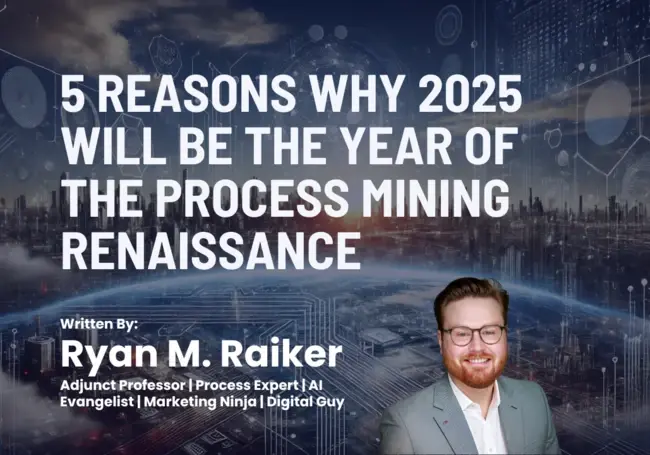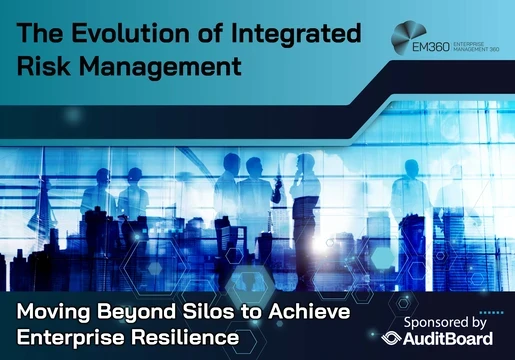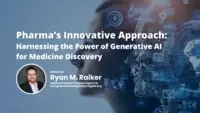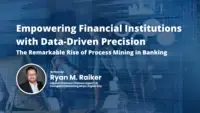
As we approach 2025, the business and technology landscapes are undergoing profound transformations. Among the key trends driving these changes is the resurgence of process mining, a technology that has evolved from a niche tool into a critical component of digital transformation strategies. The year 2025 is poised to be a landmark year for process mining, marking what many are calling the "Process Mining Renaissance." But what makes 2025 so significant for this technology? Here are five compelling reasons why 2025 will be the year of the process mining renaissance.
1. Technological Advancements are Reaching Maturity
Process mining has benefited immensely from the rapid advancements in technology over the past decade. By 2025, several key technological developments will have matured, making process mining more powerful and accessible than ever before.
AI and Machine Learning Integration: Process mining tools in 2025 will be deeply integrated with AI and machine learning capabilities, allowing businesses to not only visualize and analyze their processes but also predict outcomes and optimize them in real-time. These AI-driven insights will enable organizations to anticipate and address potential issues before they escalate, leading to more efficient and resilient operations.Scalability and Cloud Adoption: The widespread adoption of cloud computing has made it easier for businesses to scale their process mining efforts. In 2025, cloud-based process mining platforms will offer seamless integration with other enterprise systems, enabling organizations to analyze vast amounts of data from multiple sources effortlessly. This scalability will be crucial as businesses continue to grow and diversify their operations.Enhanced User Experience: By 2025, process mining tools will have evolved to offer more intuitive interfaces and advanced visualization techniques. These improvements will empower non-technical users to leverage process mining insights without needing deep technical expertise, democratizing access to process optimization across organizations.
2. Widespread Adoption Across Industries
While process mining was initially embraced by industries like manufacturing and finance, 2025 will see its adoption spread across a broader range of sectors. The growing recognition of process mining's value in optimizing operations and driving business outcomes has led to its expansion into new areas.
Healthcare: The healthcare industry, for example, will increasingly use process mining to improve patient care by optimizing treatment processes, reducing wait times, and enhancing overall operational efficiency. As healthcare providers face growing pressures to deliver high-quality care while managing costs, process mining will become an indispensable tool.Retail: Retailers will leverage process mining to streamline their supply chains, optimize inventory management, and enhance the customer experience. By analyzing customer journeys and interactions, retailers can identify bottlenecks and inefficiencies, leading to more personalized and efficient service.Public Sector: Governments and public sector organizations will adopt process mining to improve service delivery and ensure transparency in their operations. By analyzing processes related to public services, tax collection, and regulatory compliance, these organizations can enhance efficiency and accountability.
3. Focus on Sustainability and Efficiency
As businesses continue to prioritize sustainability and efficiency, process mining will play a crucial role in helping them achieve their goals. By 2025, organizations across the globe will be under increasing pressure to reduce their environmental impact, optimize resource usage, and enhance operational efficiency.
Sustainability Initiatives: Process mining will enable businesses to identify and eliminate waste, reduce energy consumption, and streamline supply chains. For example, a logistics company might use process mining to optimize transportation routes, reducing fuel consumption and carbon emissions. In industries where sustainability is becoming a key differentiator, process mining will be instrumental in achieving green goals.Operational Efficiency: The focus on efficiency will drive the adoption of process mining as companies seek to reduce costs and improve profitability. By identifying bottlenecks, inefficiencies, and deviations in their processes, organizations can implement targeted improvements that lead to significant cost savings and productivity gains.
4. Synergy with Emerging Technologies
The year 2025 will see process mining increasingly integrated with other emerging technologies, creating powerful synergies that drive innovation and business transformation.
Robotic Process Automation (RPA): The combination of process mining with RPA will be a game-changer for businesses looking to automate repetitive tasks and optimize workflows. Process mining will help organizations identify the best candidates for automation, ensuring that RPA initiatives deliver maximum value. By 2025, we can expect to see widespread deployment of RPA powered by process mining insights, leading to more efficient and agile operations.Blockchain: In industries where transparency and traceability are critical, such as supply chain management, the integration of process mining with blockchain technology will provide unprecedented levels of accountability. Blockchain will ensure that processes are executed as intended, while process mining will analyze and optimize these processes for better outcomes.Internet of Things (IoT): The proliferation of IoT devices will generate massive amounts of data that can be analyzed using process mining. By 2025, businesses will leverage this data to gain real-time insights into their operations, enabling them to respond quickly to changing conditions and optimize their processes on the fly.
5. Evolving Regulatory and Compliance Landscape
As regulatory environments become more complex, organizations will increasingly turn to process mining to ensure compliance and mitigate risks. By 2025, the need for transparency and accountability will drive the adoption of process mining across industries with stringent regulatory requirements.
Financial Services: In the financial sector, process mining will be used to monitor and audit processes related to transactions, fraud detection, and regulatory reporting. By providing a clear view of how processes are executed, process mining will help financial institutions stay compliant with evolving regulations and avoid costly penalties.Healthcare Compliance: In healthcare, process mining will play a crucial role in ensuring compliance with regulations related to patient data, treatment protocols, and billing practices. By analyzing processes in real-time, healthcare providers can identify and address compliance gaps, reducing the risk of legal and financial repercussions.Data Privacy and Security: As data privacy regulations such as GDPR and CCPA continue to evolve, process mining will help organizations ensure that they handle data in accordance with the law. By providing insights into how data flows through their systems, organizations can identify potential vulnerabilities and take proactive measures to secure sensitive information.
The year 2025 is set to be a defining moment for process mining—a year in which this transformative technology will come into its own as a critical driver of business success. As technological advancements reach maturity, adoption spreads across industries, and the focus on sustainability, efficiency, and compliance intensifies, process mining will become an indispensable tool for organizations worldwide.
The process mining renaissance is not just a passing trend; it is a fundamental shift in how businesses approach process optimization and digital transformation. Those who embrace this technology in 2025 will be well-positioned to thrive in an increasingly competitive and complex world, leading the way into a new era of innovation and growth.














Comments ( 0 )